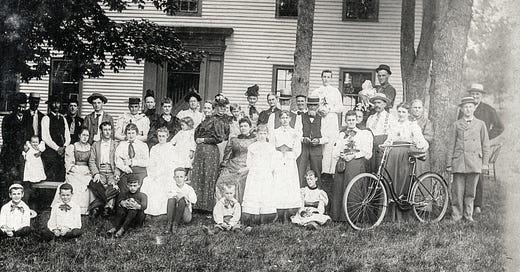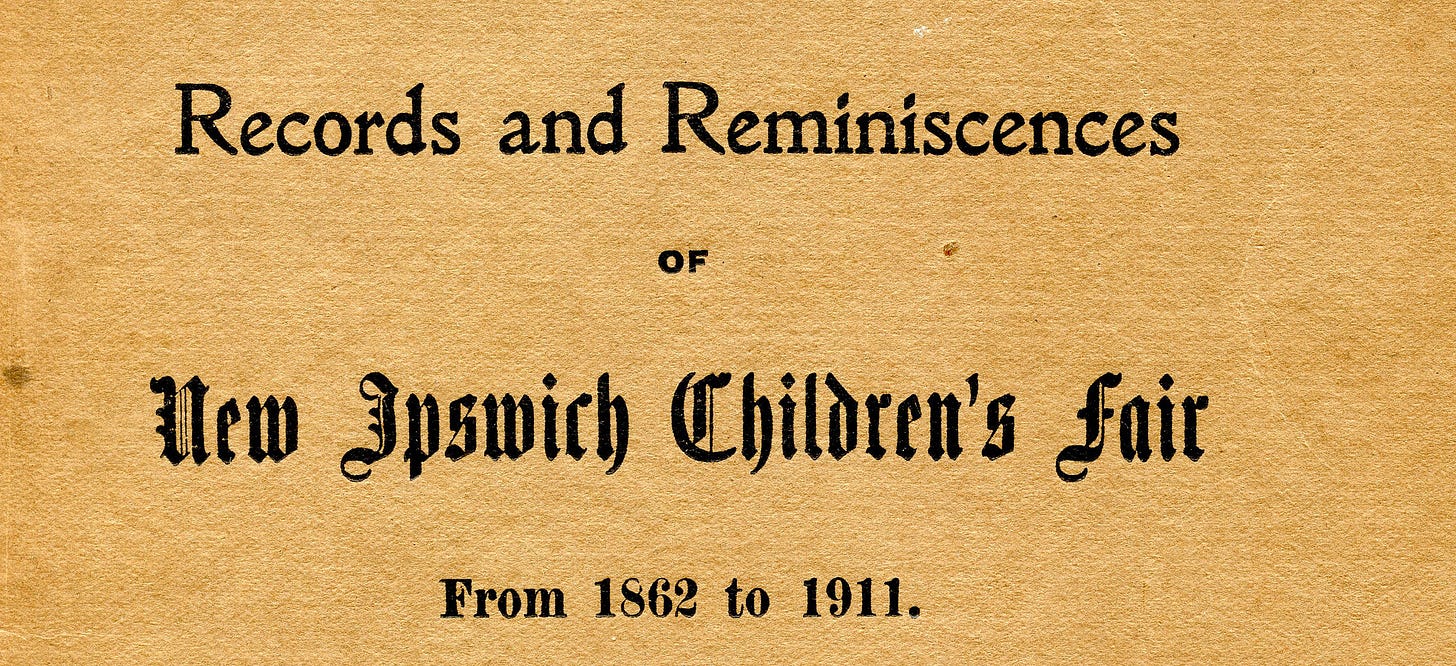Picnic at Mary Locke Shattuck in New Ipswich taken in 1893 or 1894. Oliver Brooks, Charlie Wilson, Abbie Wilson, Will Coleman, Winona Coleman, Mary Bucknam, Mrs. Marcellus Robbins, Mrs. Russell Farewell,G. Hastings & Mildred, Mrs. Charlie Wheeler, Mrs. Bucknam, Mrs. Marie Field, Ella Beard, Nellie Mansfield, Mary Mansfield, Mrs. Ferrine, Mrs. James Neuvis, Mr. Addison Wheeler, Mrs. Crockett, Bert Howe & Milton, Mrs. John Black, Lizzie Crowell, Mr. & Mrs. Bucknam, Kate Bucknam, Mr. Augustus Wheeler, Barclay Lanahu, Mrs. Russell Farwell, Two Raymond Boys, Charles Tobey, Mansfield Boy, Marman Crowell. Photo given by Herbert F. Preston, Photo taken by Leon R. Willard.
On this day - July 29, 1908
James Roger diary entry
29th (Wednesday)
Cloudy morning, warm day, wind west. David at Ashburnham. I picked one fowl. Jessie, Alice, Johnnie, and I went berry picking in forenoon. Picked about 9 quarts. I trimmed some lots in afternoon. Saw Mr. Eagleson fixing a lot for his baby grave.
On this day - July 29, 1897
William Jurian Kaula diary - Gloomy Gus
A few melancholy days - I suppose I have been eating too much again. Gloomy because I do not feel well, and the serious way in which I examine my studies and works that seem to have cost so much labor and with such poor results. I have devoted most of my attention this summer to painting effects of sunlight with the intention of putting as much vigor and the life of the great variety of color as I could command. I know that these strong effects are not recognized as having as much "feeling" and "sentiment" as the more subtle effects of early morn or evening. I want to paint them also but I am waiting until I have a keener observation and a more refined penetration if it will ever come, with an ability to put it on canvas as well as to be able to talk or write about it. Why do so many men paint the sad and pathetic? Why do not more men paint things that are gay, joyous, and full of a healthy spirit? What is there that is soothing about a picture of a funeral? or the last moments of some one dying in misery? They appeal to the Public! So do the chromoes of spoony lovesick couples loitering against a stone wall or on a rustic bridge. I open a Salon catalogue at this moment and the first picture that strikes my eye is "La ligende de la mort en Brasse-Bretagne"* - I remember the canvas very visibly, the apparition of the sailor was really gohstly [sic] and the whole well painted but it made me shudder with the realism. Next I notice "Ballade des Pendus" - the ballad of those hanged - a few corpses strung on trees - very cheerful. "Le vagabond." I notice a large number of pictures cheifly [sic] of nudes that have such charming titles as "Au Paradis", "Idylle", "Bacchus Enfant", "L'orpheline, Nymphe á la source", "Phychí et "Amour" and so on. As luck will have it I opened an art magazine with a description of the first work I mentioned of this class - Au Paradis - and this is the gush. "Standing, like a flower in her delicate flesh, amid the blooms of Eden, sheltered 'neath the Tree of Knoweledge [sic], with all the wonders of the rosy sunset gleaming in the peaceful waters, is the M. Lucien Levy-Dhurmer painting, Eve. Temptation lurks in all around. The blossoms at her feet cast their sweet scent upward; the butterflies flutter by, the blue lizards run through the grass. Everything teems with life, seduces and suggests, and there above her head, uncoiling his jewelled rings, the legendary serpent utters the tempting words. She is half smiling, and emotion trembles on her drooping eyelids. In her all womankind is seen! This is the work of painter and poet at once, a real work of art, delicate and sincere, a work which must attract all those who look for something more in painting than a mere display or virtuosity." After indulging in such enthusiasm as this the critic complains that at the Champs-Elysées there is not much to be found! His delight is such a sickly and insipid work must have made him blind to a great many works of a similar nature and even more real merit. I studied that work during one of my most sentimental moods and I must be a brute for all I could think about was that it would make an excellent picture for a cigar-box cover. I felt too much that it was a French model and French landscape - very naive is it not?
* La ligende de la mort = Dealings with the dead
Records and Reminiscences of the New Ipswich Children’s Fair from 1862 to 1911 - Songs and Poems (page 47)
SOME OF THE CONTRIBUTIONS made to the CHILDREN'S FAIR OF NEW IPSWICH in the last Fifty Years.
SONG SUNG AT THE FIRST FAIR IN 1862.
Led by STEPHEN SYLVESTER.
Tune- Marching Along.
From the cold arctic regions of lands far away,
From the groves of the South, from the isles of the sea, From the far distant East, from the West, comes the cry, "Oh, give us the Gospel, in darkness we die."
Refrain.
Marching along, we are marching along, We have lifted our standard to right all the wrong. The Lord is our Helper, in Him we are strong, We're sure to be victors, we're marching along!
Whole nations in darkness are asking for light.
The Gospel alone will illumine their night,
We have sent out our vanguard, we'll strengthen their hands. Till the realms of the foe are Immanuel's land.
Refrain.
The silver and gold they belong to the Lord, The herds on the hills they exist by His word. Rich harvests He gives us, to Him they belong, We give back a portion with gladness and song.
Refrain.







Mary Shattuck married Amos Shattuck, descendant of Lemuel Shattuck from Ashby who later became a well known merchant in Concord, Mass. Shattuck truly began to make changes in public health when he moved to Boston in 1835. He maintained a bookstore, but he was soon elected as a Massachusetts State Representative. He introduced several progressive reforms for Boston, but he truly changed the face of public health when he was asked to compile a report on sanitation in Boston. So it was that, in 1850, he published his groundbreaking Report for the Sanitary Commission.
In the late 1950's the State of Massachusetts built a new hospital in Jamaica Plain, Mass and named it the Lemuel Shattuck Hospital. It was research hospital devoted to chronic disease. Each of Boston's Medical Schools had medical residents there. One had to apply to get in. Patients had to agree to receiving new treatments. Mass residents were given preference but I remember working on a young boy from Rindge, NH while I was there. The Lemuel Shattuck Hospital today is devoted to solving the country's drug addiction problem.